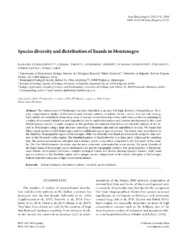Приказ основних података о документу
Species diversity and distribution of lizards in Montenegro
| dc.creator | Ljubisavljević, Katarina | |
| dc.creator | Tomović, Ljiljana | |
| dc.creator | Urošević, Aleksandar | |
| dc.creator | Gvozdenović, Slađana | |
| dc.creator | Iković, Vuk | |
| dc.creator | Zagora, Vernes | |
| dc.creator | Labus, Nenad | |
| dc.date.accessioned | 2018-07-20T08:07:27Z | |
| dc.date.available | 2018-07-20T08:07:27Z | |
| dc.date.issued | 2018 | |
| dc.identifier.uri | http://www.fupress.net/index.php/ah/article/view/21327 | |
| dc.identifier.uri | https://radar.ibiss.bg.ac.rs/handle/123456789/3098 | |
| dc.description.abstract | The southern part of Montenegro has been identified as an area with high diversity of herpetofauna. However, comprehensive studies of distribution and diversity patterns of reptiles on the country level are still missing. Such studies are essential in designating areas of special conservation importance and nature protection planning in a milieu of increased habitat loss and degradation due to rapid urbanization and tourism development in this small Mediterranean country. To make progress on this problem, we analyzed distribution and diversity patterns of the lizards in Montenegro using a large database consisting of literature data and our unpublished records. We found that fifteen lizard species inhabit Montenegro, and two additional species may be present. The lizards were most diverse in the Maritime biogeographic region of Montenegro, while low diversity was found predominantly along the state borders in the Mountain-valley region. The identified pattern of lizard diversity is at least partly influenced by sampling bias. The eastern mountainous subregion had a distinct species composition compared to all other parts of the country. The East-Mediterranean chorotype was the most dominant, represented by seven species. The great diversity of the lizard fauna of Montenegro can be attributed to its specific topographic position with great influence of Mediterranean climate, heterogeneity of biomes, complex geological history and diverse physiogeographic features. High lizard species richness in the Maritime region and a unique species composition in the eastern subregion of Montenegro indicate that these areas are of high conservation interest. | en |
| dc.relation | info:eu-repo/grantAgreement/MESTD/Basic Research (BR or ON)/173043/RS// | |
| dc.relation | Rufford Foundation (14714-1) | |
| dc.relation | Rufford Foundation (19600-2) | |
| dc.relation | Rufford Foundation (19309-2) | |
| dc.rights | openAccess | |
| dc.rights.uri | https://creativecommons.org/licenses/by/4.0/ | |
| dc.source | Acta Herpetologica | |
| dc.subject | Balkan Peninsula | |
| dc.subject | Distribution pattern | |
| dc.subject | Lacertilia | |
| dc.subject | Species richness | |
| dc.title | Species diversity and distribution of lizards in Montenegro | en |
| dc.type | article | en |
| dc.rights.license | BY | |
| dcterms.abstract | Иковић, Вук; Лабус, Ненад; Томовић, Љиљана; Загора, Вернес; Љубисављевић, Катарина; Урошевић, Aлександар; Гвозденовић, Слађана; | |
| dc.rights.holder | © Firenze University Press | |
| dc.citation.issue | 1 | |
| dc.citation.volume | 13 | |
| dc.identifier.doi | 10.13128/acta_herpetol-21327 | |
| dc.identifier.scopus | 2-s2.0-85049164154 | |
| dc.identifier.wos | 000438364800001 | |
| dc.citation.apa | Ljubisavljević, K., Tomović, L., Urošević, A., Gvozdenović, S., Iković, V., Zagora, V., & Labus, N. (2018). Species diversity and distribution of lizards in Montenegro. Acta Herpetologica, 13(1), 3–11. | |
| dc.citation.vancouver | Ljubisavljević K, Tomović L, Urošević A, Gvozdenović S, Iković V, Zagora V, Labus N. Species diversity and distribution of lizards in Montenegro. Acta Herpetol. 2018;13(1):3–11. | |
| dc.citation.spage | 3 | |
| dc.citation.epage | 11 | |
| dc.type.version | publishedVersion | en |
| dc.identifier.fulltext | https://radar.ibiss.bg.ac.rs//bitstream/id/4370/ActaHerpetol_2018_13_1_3-11.pdf | |
| dc.citation.rank | M23 |

